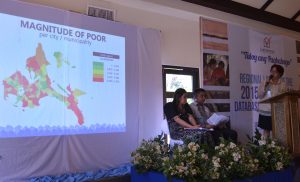
A total of 202,279 households in the CALABARZON Region are poor, announced the Department of Social Welfare and Development (DSWD) Field Office IV-A during the Regional Launching of the Listahanan 2015 Database of Poor Households in Tagaytay Country Hotel, Tagaytay City last June 20.
The said number of poor households is identified based on the assessment of the 1,346,324 households across the region from April to December 2015 under the Department’s Listahanan targeting system.
The Listahanan, previously the National Household Targeting System for Poverty Reduction (NHTS-PR), is an information management and targeting system that identifies who and where the poor are in the country. It generates a comprehensive and objective database of the poor, which is utilized by the DSWD in targeting beneficiaries of its programs and services for the poor.
The said number of poor households in the region represents 3.95 percent of the 5,116,976 poor households in the country.
In the region, Quezon Province has a total of 80,748 poor households, the highest magnitude of the poor among the CALABARZON provinces. Batangas has 39,945; Laguna has 31,484; Cavite has 29,441, and; Rizal has 20,661 poor households.
All these data are based on the February 2016 database of the poor of the Listahanan.
Listahanan—a reliable database of the poor
“The identification of the poor households followed an objective process where our field staff conducted a house-to-house assessment and collected the socio-economic data of every household to determine whether they are poor or non-poor,” said DSWD IV-A Regional Director Leticia T. Diokno.
She added that the DSWD used a uniform instrument, called the Family Assessment Form, that predicted the income of households through collecting data such as family composition, employment, education of household members, housing condition and access to basic services.
“Also part of the process of the Listahanan is the validation phase where the DSWD posted the initial list of poor households in every barangay to collect complaints from local residents as to the inclusion of non-poor households or exclusion of poor households in the database,” Dir. Diokno added.
This new database of the poor updates the list generated in 2009 during the first assessment of poor households conducted by the DSWD.
In the 2009 assessment, a total of 404,707 households are poor out of the 949,583 assessed in the CALABARZON Region.
Providing services to the poor
The DSWD also emphasizes that households included in the database of the poor of the Listahanan are not guaranteed with a program or service.
“The Listahanan is a targeting system, and being included in its database does not mean a program for the household. Still, the inclusion of a household to any program of the DSWD, particularly the Pantawid Pamilyang Pilipino Program, is subject to a household’s eligibility to the program as well as the expansion of the program for more beneficiaries,” said Dir. Diokno.
However, the DSWD will be utilizing the said database in targeting beneficiaries for its various programs and services for the poor and planning for interventions, especially in providing these households with opportunities to help improve their living condition.
To date, the said targeting system is being used in the identification of beneficiaries of the DSWD’s Pantawid Pamilyang Pilipino Program and Social Pension for Indigent Senior Citizens.
Further, the DSWD calls for other stakeholders to direct their resources in helping these poor families.
“We seek the support of our partners including our local government units and civil society organizations to use the Listahanan database of the poor in planning for programs and services for the poor,” Dir. Diokno said.#
